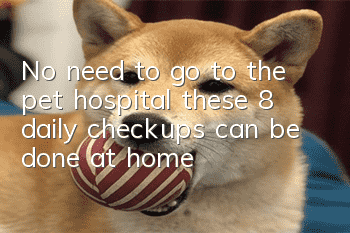No need to go to the pet hospital, these 8 daily checkups can be done at home!

Dogs are the dog’s most loyal partner and also his family. In order to make the dog live longer and healthier, the dog should also conduct regular physical examinations for the dog.
But in fact, some examinations do not necessarily have to be done at a professional pet hospital. The pet owner can also perform them at home.
Today I’m going to teach you some inspection techniques!
1. Touch your nose
If the dog's nose is wet, it means he is healthy; if it is dry, it means he is uncomfortable or about to get sick, and needs more attention and hydration.
Of course, it is normal for a dog to have a dry nose when he first wakes up.
2. Make eye contact
Check whether the dog is tearful, observe whether the color of the dog's tear glands becomes darker, and reflect on whether the dog is fed too salty or eats too well.
3. Smell your breath
When the scavenger is getting close to the dog, get close to the dog’s mouth and smell whether its breath is fresh. If there is a smell, it means there may be oral disease! Especially for older dogs, you need to pay more attention.
4. Turn your ears
If your dog’s ears have a foul smell and keep shaking its head, it means there is something dirty or inflammation in the ears.
Sometimes the dog’s ears are just dirty, so just wipe them clean with a wet tissue or alcohol cotton.
If there is brown stuff from the ear hole to the auricle, then you need to take care of it.
If it is a dog with long hair in its ears, check to see if the hair has grown again and whether it is necessary to pluck it out.
5. Shake hands with it
When playing with a dog, turn over the dog's foot pads to see if there are any cracks and whether the hair inside has grown longer.
Use your hands to feel whether there are any breaks or small pustules between your toes, whether your nails are sharp and need to be trimmed, and then feel up your legs to see if there are any pustules.
6. Pet the dog
When petting a dog, consciously touch the dog's chin, behind the ears, the back of the neck, the base of the tail and the belly.
In this way, you can find whether the hair is tangled, whether there are small pimples, lumps, etc. on the skin.
Look for small brown or red dots and flakes of skin falling off. If there are any, the dog may be infected with mites.
7. Look at your butt
A dog’s normal anus is slightly concave and has no particularly obvious odor.
If your dog is obviously sitting and rubbing its butt, you should check if the anus is red and swollen in time. If it is inflamed, it will swell and protrude outward, and the smell will be very smelly, so you need to go to the pet hospital for treatment.
If you know how to express your anal glands, clean your dog’s anal glands in time.
8. Check feces
When the dog owner takes the dog out for a walk every day, the main purpose is to let it excrete.
It is best for poop scrapers to see with their own eyes whether the dog's poop is dry or loose, so as to keep abreast of the physical condition and adjust the diet so that the dog's poop is smooth and beautiful every day.
Have you learned anything after reading this?
Poop shoveler, do you have any tips for checking your dog?
- What are the signs of illness in golden retrievers?
- When does a dog’s awkward period begin?
- What are the symptoms before a Border Collie gives birth? Preparation for a Shepherd’s delivery!
- What are the reasons why French Dou cry so much?
- How much does it cost to neuter a male cat? Details on the price of neutering a male cat!
- How many months does it take for a dog to urinate and defecate regularly?
- What does it mean when a dog barks?
- What’s the matter with red, swollen and protruding dog eyes?
- Why does a dog keep barking at its owner?
- How to easily trim your pet’s nails



